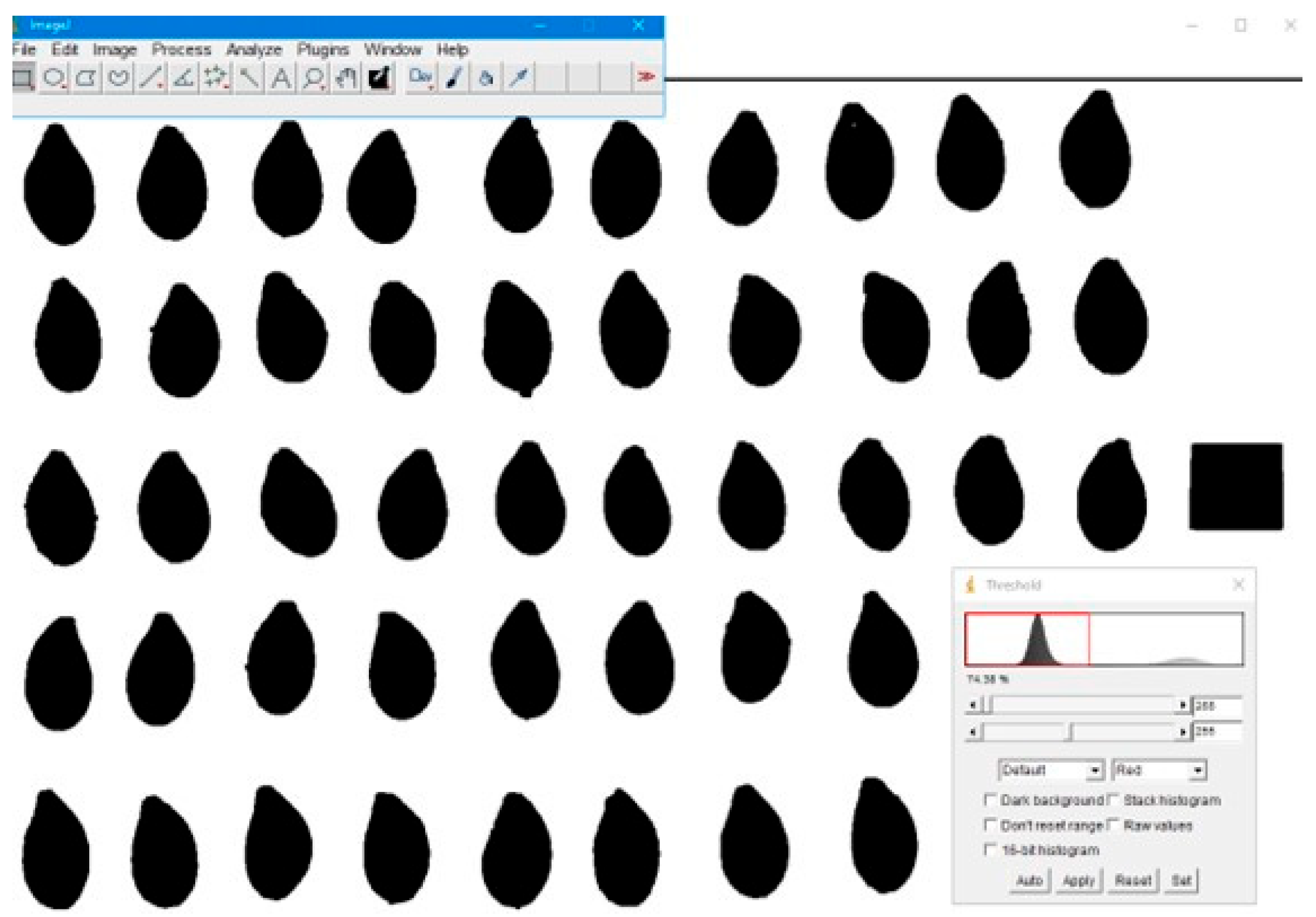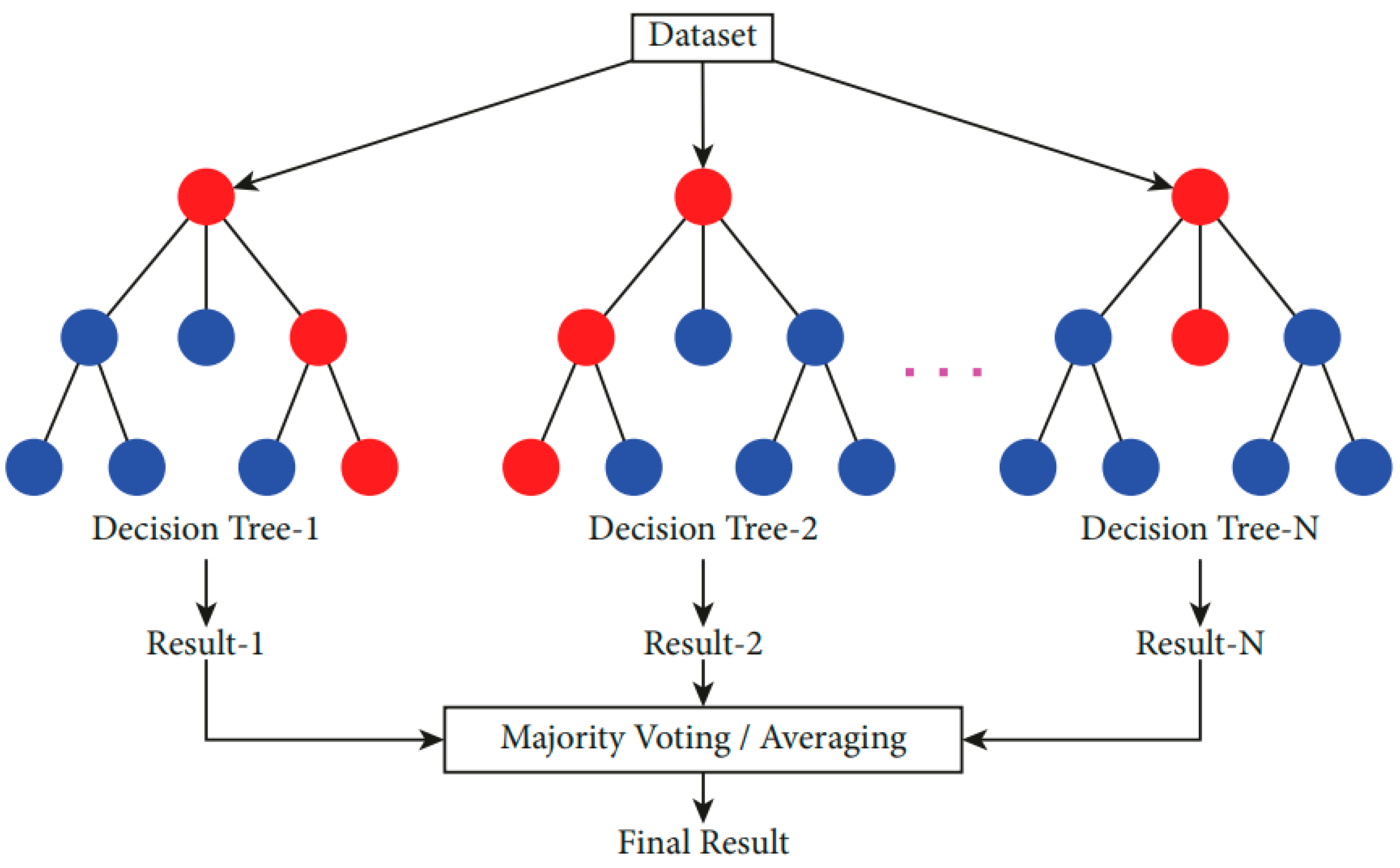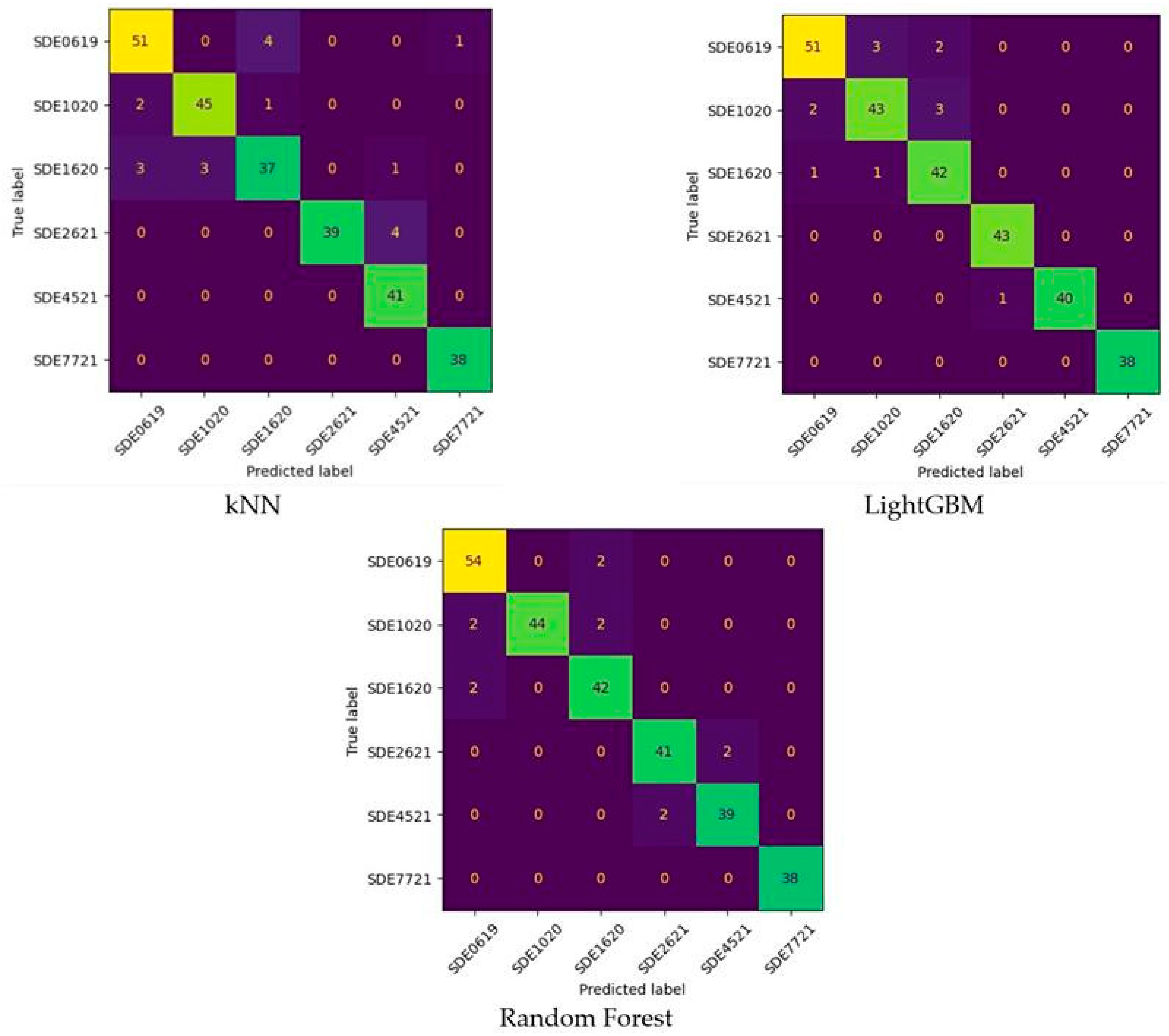Machine Learning-Based Morphological Classification and Diversity Analysis of Ornamental Pumpkin Seeds
Abstract
1. Introduction
2. Materials and Methods
2.1. Plant Material and Experimental Site
2.2. Machine Learning
2.2.1. Random Forests
2.2.2. LightGBM
2.2.3. k-Nearest Neighbors (kNN)
3. Results and Discussion
3.1. Statistical Analysis
3.2. Evaluation Metrics
3.3. Based on Machine Learning Method
3.4. Based on Evaluation Metrics
4. Conclusions
Author Contributions
Funding
Institutional Review Board Statement
Informed Consent Statement
Data Availability Statement
Acknowledgments
Conflicts of Interest
References
- Schaffer, A.A.; Paris, H.S. Melons, squashes, and gourds. In Encyclopedia of Food Sciences and Nutrition; Academic Press: Cambridge, MA, USA, 2003; pp. 3817–3826. [Google Scholar] [CrossRef]
- Schaefer, H.; Heibl, C.; Renner, S.S. Gourds Afloat: A Dated Phylogeny Reveals an Asian Origin of the Gourd Family (Cucurbitaceae) and Numerous Oversea Dispersal Events. Proc. R. Soc. B Biol. Sci. 2012, 276, 843–851. [Google Scholar] [CrossRef] [PubMed]
- Ferriol, M.; Picó, B. Pumpkin and Winter Squash. In Vegetables I; Prohens, J., Nuez, F., Eds.; Springer: Madrid, Spain, 2008; pp. 317–349. [Google Scholar]
- Hernandez, C.O.; Labate, J.; Reitsma, K.; Fabrizio, J.; Bao, K.; Fei, Z.; Grumet, R.; Mazourek, M. Characterization of the USDA Cucurbita pepo, C. Moschata, and C. Maxima Germplasm Collections. Front. Plant Sci. 2023, 14, 1130814. [Google Scholar] [CrossRef] [PubMed]
- Paris, H.S. Genetic Resources of Pumpkins and Squash, Cucurbita spp. In Genetics and Genomics of Cucurbitaceae; Grumet, R., Nurit, K., Jordi, G.-M., Eds.; Springer Nature: Cham, Switzerland, 2016; pp. 111–154. [Google Scholar]
- Nee, M. The Domestication of Cucurbita (Cucurbitaceae). Econ. Bot. 1990, 44, 56–68. [Google Scholar] [CrossRef]
- Montes-Hernández, S.; Merrick, L.C.; Eguiarte, L.E. Maintenance of Squash (Cucurbita spp.) Landrace Diversity by Farmers’ Activities in Mexico. Genet. Resour. Crop Evol. 2005, 52, 697–707. [Google Scholar] [CrossRef]
- Paris, H.S. Germplasm Enhancement of Cucurbita pepo (Pumpkin, Squash, Gourd: Cucurbitaceae): Progress and Challenges. Euphytica 2016, 208, 415–438. [Google Scholar] [CrossRef]
- Paris, H.S.; Lebeda, A.; Křistkova, E.; Andres, T.C.; Nee, M.H. Parallel Evolution Under Domestication and Phenotypic Differentiation of the Cultivated Subspecies of Cucurbita pepo (Cucurbitaceae). Econ. Bot. 2012, 66, 71–90. [Google Scholar] [CrossRef]
- Paris, H.S. History of the Cultivar-Groups of Cucurbita pepo. In Horticultural Review; Janick, J., Ed.; John Wiley & Sons, Inc.: Hoboken, NJ, USA, 2000; pp. 71–170. [Google Scholar]
- Barzegar, R.; Peyvast, G.; Ahadi, A.M.; Rabiei, B.; Ebadi, A.A.; Babagolzadeh, A. Biochemical Systematic, Population Structure and Genetic Variability Studies among Iranian Cucurbita (Cucurbita pepo L.) Accessions, Using Genomic SSRs and Implications for Their Breeding Potential. Biochem. Syst. Ecol. 2013, 50, 187–198. [Google Scholar] [CrossRef]
- Ferriol, M.; Picó, B.; Nuez, F. Genetic Diversity of a Germplasm Collection of Cucurbita pepo Using SRAP and AFLP Markers. Theor. Appl. Genet. 2003, 107, 271–282. [Google Scholar] [CrossRef]
- Paris, H.S.; Nerson, H. Seed Dimensions in the Subspecies and Cultivar-Groups of Cucurbita pepo. Genet. Resour. Crop Evol. 2003, 50, 615–625. [Google Scholar] [CrossRef]
- Goldman, A. The Compleat Squash: A Passionate Grower’s Guide to Pumpkins, Squash, and Gourds; New York Artisan: New York, NY, USA, 2004. [Google Scholar]
- Kates, H.R. Pumpkins, Squashes, and Gourds (Cucurbita L.) of North America. N. Am. Crop Wild Relat. Important Species 2019, 2, 195–224. [Google Scholar] [CrossRef]
- Xanthopoulou, A.; Montero-Pau, J.; Mellidou, I.; Kissoudis, C.; Blanca, J.; Picó, B.; Tsaballa, A.; Tsaliki, E.; Dalakouras, A.; Paris, H.S.; et al. Whole-Genome Resequencing of Cucurbita pepo Morphotypes to Discover Genomic Variants Associated with Morphology and Horticulturally Valuable Traits. Hortic. Res. 2019, 6, 94. [Google Scholar] [CrossRef] [PubMed]
- Şekerci, A.D.; Karaman, K.; Yetişir, H. Characterization of Ornamental Pumpkin (Cucurbita pepo L. Var. Ovifera (L.) Alef.) Genotypes: Molecular, Morphological and Nutritional Properties. Genet. Resour. Crop Evol. 2020, 67, 533–547. [Google Scholar] [CrossRef]
- Decker, D.S. Numerical Analysis of Archaeological Cucurbita Seeds from Hontoon Island, Florida. Biology 1988, 8, 34–44. [Google Scholar]
- Sekerci, A.D.; Karaman, K.; Yetisir, H.; Sagdic, O. Change in Morphological Properties and Fatty Acid Composition of Ornamental Pumpkin Seeds (Cucurbita pepo Var. ovifera) and Their Classification by Chemometric Analysis. J. Food Meas. Charact. 2017, 11, 1306–1314. [Google Scholar] [CrossRef]
- Decker, D.S.; Wilson, H.D. Allozyme Variation in the Cucurbita pepo complex: C. pepo var. ovifera vs. C. texana. Syst. Bot. 1987, 12, 263–273. [Google Scholar] [CrossRef]
- Smith, B.D. Seed Size Increase as a Marker of Domestication in Squash (Cucurbita pepo). In Documenting Domestication: New Genetic and Archaeological Paradigms; University of California Press: Berkeley, CA, USA, 2006; pp. 25–31. [Google Scholar] [CrossRef]
- Gadotti, G.I.; Ascoli, C.A.; Bernardy, R.; Monteiro, R.d.C.M.; Pinheiro, R.d.M. Machine learning for soybean seeds lots classification. Eng. Agricola 2022, 42, e20210101. [Google Scholar] [CrossRef]
- Çetin, N.; Ropelewska, E.; Fidan, S.; Ülkücü, Ş.; Saban, P.; Günaydın, S.; Ünlükara, A. Binary Classification of Pumpkin (Cucurbita pepo L.) Seeds Based on Quality Features Using Machine Learning Algorithms. Eur. Food Res. Technol. 2024, 250, 409–423. [Google Scholar] [CrossRef]
- Henrietta, H.M. Artificial Intelligence in Agriculture: A Review of Current Applications and Future Trends. In Intelligent Futuristic Trends in Agriculture Engineering & Food Sciences; Selfypage Developers Pvt. Ltd.: Chikmagalur, India, 2024; Volume 3, pp. 1–6. [Google Scholar]
- Al Fahim, H.; Hasan, M.A.; Bijoy, M.H.I.; Reza, A.W.; Arefin, M.S. Seeds Classification Using Deep Neural Network: A Review. In Intelligent Computing & Optimization; Springer Nature: Cham, Switzerland, 2023; pp. 168–182. ISBN 9783031503290. [Google Scholar]
- Kumar, V.; Aydav, P.S.S.; Minz, S. Crop Seeds Classification Using Traditional Machine Learning and Deep Learning Techniques: A Comprehensive Survey. SN Comput. Sci. 2024, 5, 1031. [Google Scholar] [CrossRef]
- Subeesh, A.; Mehta, C.R. Automation and Digitization of Agriculture Using Artificial Intelligence and Internet of Things. Artif. Intell. Agric. 2021, 5, 278–291. [Google Scholar] [CrossRef]
- Naeem, S.; Ali, A.; Anam, S.; Ahmed, M.M. An Unsupervised Machine Learning Algorithms: Comprehensive Review. Int. J. Comput. Digit. Syst. 2023, 13, 911–921. [Google Scholar] [CrossRef]
- Hassan, J.; Saeed, S.M.; Deka, L.; Uddin, M.J.; Das, D.B. Applications of Machine Learning (ML) and Mathematical Modeling (MM) in Healthcare with Special Focus on Cancer Prognosis and Anticancer Therapy: Current Status and Challenges. Pharmaceutics 2024, 16, 260. [Google Scholar] [CrossRef] [PubMed]
- Uzal, L.C.; Grinblat, G.L.; Namías, R.; Larese, M.G.; Bianchi, J.S.; Morandi, E.N.; Granitto, P.M. Seed-per-Pod Estimation for Plant Breeding Using Deep Learning. Comput. Electron. Agric. 2018, 150, 196–204. [Google Scholar] [CrossRef]
- Chen, Y.; Wu, Z.; Zhao, B.; Fan, C.; Shi, S. Weed and Corn Seedling Detection in Field Based on Multi Feature Fusion and Support Vector Machine. Sensors 2021, 21, 212. [Google Scholar] [CrossRef]
- Balducci, F.; Impedovo, D.; Pirlo, G. Machine Learning Applications on Agricultural Datasets for Smart Farm Enhancement. Machines 2018, 6, 38. [Google Scholar] [CrossRef]
- Gulzar, Y.; Hamid, Y.; Soomro, A.B.; Alwan, A.A.; Journaux, L. A Convolution Neural Network-Based Seed Classification System. Symmetry 2020, 12, 2018. [Google Scholar] [CrossRef]
- Singh, P.; Nayyar, A.; Singh, S.; Kaur, A. Classification of Wheat Seeds Using Image Processing and Fuzzy Clustered Random Forest. Int. J. Agric. Resour. Gov. Ecol. 2020, 16, 123–156. [Google Scholar] [CrossRef]
- Thyagharajan, K.K.; Kiruba Raji, I. A Review of Visual Descriptors and Classification Techniques Used in Leaf Species Identification. Arch. Comput. Methods Eng. 2018, 26, 933–960. [Google Scholar] [CrossRef]
- Huang, S.; Fan, X.; Sun, L.; Shen, Y.; Suo, X. Research on Classification Method of Maize Seed Defect Based on Machine Vision. J. Sens. 2019, 2019, 2716975. [Google Scholar] [CrossRef]
- Dheer, P.; Singh, P.V. Classifying Wheat Varieties Using Machine Learning Model. J. Pharmacogn. Phytochem. 2019, 8, 47–49. [Google Scholar] [CrossRef]
- Guevara-Hernández, F.; Gómez Gil, J. A Machine Vision System for Classification of Wheat and Barley Grain Kernels. Spanish J. Agric. Res. 2011, 9, 672–680. [Google Scholar] [CrossRef]
- Demir, B.; Eski, I.; Kus, Z.A.; ErcislI, S. Prediction of Physical Parameters of Pumpkin Seeds Using Neural Network. Not. Bot. Horti Agrobot. Cluj-Napoca 2017, 45, 22–27. [Google Scholar] [CrossRef][Green Version]
- de Medeiros, A.D.; Capobiango, N.P.; da Silva, J.M.; da Silva, L.J.; da Silva, C.B.; dos Santos Dias, D.C.F. Interactive Machine Learning for Soybean Seed and Seedling Quality Classification. Sci. Rep. 2020, 10, 11267. [Google Scholar] [CrossRef] [PubMed]
- de Medeiros, A.D.; Pinheiro, D.T.; Xavier, W.A.; da Silva, L.J.; dos Santos Dias, D.C.F. Quality Classification of Jatropha Curcas Seeds Using Radiographic Images and Machine Learning. Ind. Crops Prod. 2020, 146, 112162. [Google Scholar] [CrossRef]
- Çiftci, B.; Çetin, N.; Günaydın, S.; Kaplan, M. Machine Learning Approaches for Binary Classification of Sorghum (Sorghum bicolor L.) Seeds from Image Color Features. J. Food Compos. Anal. 2025, 140, 107208. [Google Scholar]
- Otsu, N. A Threshold Selection Method from Gray-Level Histograms. IEEE Trans. Syst. Man. Cybern. 1979, 9, 62–66. [Google Scholar] [CrossRef]
- Kabas, O.; Ercan, U.; Moiceanu, G. Critical Drop Height Prediction of Loquat Fruit Based on Some Engineering Properties with Machine Learning Approach. Agronomy 2024, 14, 1523. [Google Scholar] [CrossRef]
- Ercan, U.; Sonmez, I.; Kabaş, A.; Kabas, O.; Calık Zyambo, B.; Gölükcü, M.; Paraschiv, G. Quantitative Assessment of Brix in Grafted Melon Cultivars: A Machine Learning and Regression-Based Approach. Foods 2024, 13, 3858. [Google Scholar] [CrossRef]
- Hessane, A.; El Youssefi, A.; Farhaoui, Y.; Aghoutane, B.; Amounas, F. A Machine Learning Based Framework for a Stage-Wise Classification of Date Palm White Scale Disease. Big Data Min. Anal. 2023, 6, 263–272. [Google Scholar] [CrossRef]
- Koklu, M.; Sarigil, S.; Ozbek, O. The Use of Machine Learning Methods in Classification of Pumpkin Seeds (Cucurbita pepo L.). Genet. Resour. Crop Evol. 2021, 68, 2713–2726. [Google Scholar] [CrossRef]
- Ustuner, M.; Simsek, F.F. An Assessment of Training Data for Agricultural Land Cover Classification: A Case Study of Bafra, Türkiye. Earth Sci. Informatics 2025, 18, 7. [Google Scholar] [CrossRef]
- Breiman, L. Random Forests. Mach. Learn. 2001, 45, 5–32. [Google Scholar] [CrossRef]
- Kocer, A. Prediction of the Higher Heating Values of Biomass Using Machine Learning Methods Based on Proximate and Ultimate Analysis. J. Mech. Sci. Technol. 2024, 38, 1569–1574. [Google Scholar] [CrossRef]
- Rokach, L.; Maimon, O. Data Mining with Decision Trees Theory and Applications, 2nd ed.; World Scientific Publishing Co. Pte. Ltd.: Singapore, 2014. [Google Scholar]
- Aksoy, E.; Kocer, A.; Yilmaz, İ.; Akçal, A.N.; Akpinar, K. Assessing Fire Risk in Wildland–Urban Interface Regions Using a Machine Learning Method and GIS Data: The Example of Istanbul’s European Side. Fire 2023, 6, 408. [Google Scholar] [CrossRef]
- Oshiro, T.M.; Perez, P.S.; Baranauskas, J.A. How Many Trees in a Random Forest? In Proceedings of the Machine Learning and Data Mining in Pattern Recognition (MLDM 2012), Berlin, Germany, 13–20 July 2012; Lecture Notes in Computer Science. Volume 7376, pp. 154–168. [Google Scholar] [CrossRef]
- Khan, M.Y.; Qayoom, A.; Nizami, M.S.; Siddiqui, M.S.; Wasi, S.; Raazi, S.M.K.U.R. Automated Prediction of Good Dictionary EXamples (GDEX): A Comprehensive Experiment with Distant Supervision, Machine Learning, and Word Embedding-Based Deep Learning Techniques. Complexity 2021, 2021, 2553199. [Google Scholar] [CrossRef]
- Bentéjac, C.; Csörgő, A.; Martínez-Muñoz, G. A Comparative Analysis of Gradient Boosting Algorithms; Springer: Dordrecht, Netherlands, 2021; Volume 54, ISBN 0123456789. [Google Scholar]
- Ke, G.; Meng, Q.; Finley, T.; Wang, T.; Chen, W.; Ma, W.; Ye, Q.; Liu, T.-Y. LightGBM: A Highly Efficient Gradient Boosting Decision Tree. Adv. Neural Inf. Process. Syst. 2017, 30, 3149–3157. [Google Scholar]
- Li, W.; Ding, S.; Chen, Y.; Wang, H.; Yang, S. Transfer Learning-Based Default Prediction Model for Consumer Credit in China. J. Supercomput. 2019, 75, 862–884. [Google Scholar] [CrossRef]
- Üstüner, M.; Abdikan, S.; Bilgin, G.; Balık Şanlı, F. Hafif Gradyan Artırma Makineleri Ile Tarımsal Ürünlerin Sınıflandırılması. Türk Uzak. Algılama Ve CBS Derg. 2020, 1, 97–105. [Google Scholar]
- Almomany, A.; Ayyad, W.R.; Jarrah, A. Optimized Implementation of an Improved KNN Classification Algorithm Using Intel FPGA Platform: COVID-19 Case Study. J. King Saud. Univ.-Comput. Inf. Sci. 2022, 34, 3815–3827. [Google Scholar] [CrossRef]
- Lamba, A.; Kumar, D. Survey on KNN and Its Variants. Int. J. Adv. Res. Comput. Commun. Eng. 2016, 5, 430–435. [Google Scholar] [CrossRef]
- Ali, N.; Neagu, D.; Trundle, P. Evaluation of K-Nearest Neighbour Classifier Performance for Heterogeneous Data Sets. SN Appl. Sci. 2019, 1, 1559. [Google Scholar] [CrossRef]
- Ercan, U. İnternetten Alişveriş Yapan Hanelerin Rastgele Orman Yöntemiyle Tahmin Edilmesi. Kafkas Üniversitesi İktisadi Ve İdari Bilim. Fakültesi Derg. 2021, 12, 728–752. [Google Scholar] [CrossRef]
- Grandini, M.; Bagli, E.; Visani, G. Metrics for Multi-Class Classification: An Overview. arXiv 2020, arXiv:2008.05756. [Google Scholar]
- Sokolova, M.; Lapalme, G. A Systematic Analysis of Performance Measures for Classification Tasks. Inf. Process. Manag. 2009, 45, 427–437. [Google Scholar] [CrossRef]
- Jurman, G.; Riccadonna, S.; Furlanello, C. A Comparison of MCC and CEN Error Measures in Multi-Class Prediction. PLoS ONE 2012, 7, e41882. [Google Scholar] [CrossRef]
- Chicco, D.; Jurman, G. The Advantages of the Matthews Correlation Coefficient (MCC) over F1 Score and Accuracy in Binary Classification Evaluation. BMC Genom. 2020, 21, 6. [Google Scholar] [CrossRef] [PubMed]
- Yilmaz, A.E.; Demirhan, H. Weighted Kappa Measures for Ordinal Multi-Class Classification Performance. Appl. Soft Comput. 2023, 134, 110020. [Google Scholar] [CrossRef]
- Ercan, U.; Kabas, O.; Kabaş, A.; Moiceanu, G. Classification of Dragon Fruit Varieties Based on Morphological Properties: Multi-Class Classification Approach. Sustainability 2025, 17, 2629. [Google Scholar] [CrossRef]
- Li, X.; Feng, X.; Fang, H.; Yang, N.; Yang, G.; Yu, Z.; Shen, J.; Geng, W.; He, Y. Classification of Multi-Year and Multi-Variety Pumpkin Seeds Using Hyperspectral Imaging Technology and Three-Dimensional Convolutional Neural Network. Plant Methods 2023, 19, 82. [Google Scholar] [CrossRef]









| RF | kNN | LightGBM |
|---|---|---|
| n_estimators = 200, criterion = ‘entropy’, max_depth = 9, min_samples_split = 2, min_samples_leaf = 2, ma_features = ‘sqrt’ | n_neighbors = 5, weights = ‘uniform’, algorithm= ‘kd_tree’, leaf_size = 30, p = 2, metric =‘cityblock’ | boosting_type = ‘dart’, num_leaves = 800, max_depth= 7, learning_rate = 0.2, n_estimators = 1500, subsample_for_bin = 350,000 |
| Elongation (mm) | Width (mm) | Thickness (mm) | Weight (g) | L | a | b | |
|---|---|---|---|---|---|---|---|
| Min | 1.96 | 1.85 | 1.27 | 0.0248 | 7.75 | 3.04 | 1.18 |
| Max | 70.34 | 9.95 | 20.7 | 16.71 | 85.05 | 66.07 | 21.17 |
| Std Dev | 3.40 | 1.34 | 0.76 | 0.56 | 6.22 | 2.17 | 4.69 |
| Ave | 11.86 | 7.23 | 2.23 | 0.10 | 77.33 | 5.33 | 11.96 |
| Skewness | 5.84 | 0.08 | 17.58 | 29.66 | −9.04 | 24.63 | −0.28 |
| Curtosis | 96.50 | −1.18 | 399.43 | 886.31 | 98.09 | 687.71 | −0.97 |
| Number of Observations: 900 | |||||||
| Metrics | kNN | RF | LightGBM |
|---|---|---|---|
| Accuracy | 0.930 | 0.959 | 0.952 |
| Accuracy (Balanced) | 0.933 | 0.961 | 0.956 |
| Cohen’s Kappa | 0.915 | 0.951 | 0.942 |
| F1-Score (Macro) | 0.932 | 0.961 | 0.955 |
| Matthews Correlation Coefficient | 0.916 | 0.951 | 0.942 |
| Precision (Macro) | 0.933 | 0.962 | 0.955 |
| Recall (Macro) | 0.933 | 0.961 | 0.956 |
Disclaimer/Publisher’s Note: The statements, opinions and data contained in all publications are solely those of the individual author(s) and contributor(s) and not of MDPI and/or the editor(s). MDPI and/or the editor(s) disclaim responsibility for any injury to people or property resulting from any ideas, methods, instructions or products referred to in the content. |
© 2025 by the authors. Licensee MDPI, Basel, Switzerland. This article is an open access article distributed under the terms and conditions of the Creative Commons Attribution (CC BY) license (https://creativecommons.org/licenses/by/4.0/).
Share and Cite
Ermiş, S.; Ercan, U.; Kabaş, A.; Kabaş, Ö.; Moiceanu, G. Machine Learning-Based Morphological Classification and Diversity Analysis of Ornamental Pumpkin Seeds. Foods 2025, 14, 1498. https://doi.org/10.3390/foods14091498
Ermiş S, Ercan U, Kabaş A, Kabaş Ö, Moiceanu G. Machine Learning-Based Morphological Classification and Diversity Analysis of Ornamental Pumpkin Seeds. Foods. 2025; 14(9):1498. https://doi.org/10.3390/foods14091498
Chicago/Turabian StyleErmiş, Sıtkı, Uğur Ercan, Aylin Kabaş, Önder Kabaş, and Georgiana Moiceanu. 2025. "Machine Learning-Based Morphological Classification and Diversity Analysis of Ornamental Pumpkin Seeds" Foods 14, no. 9: 1498. https://doi.org/10.3390/foods14091498
APA StyleErmiş, S., Ercan, U., Kabaş, A., Kabaş, Ö., & Moiceanu, G. (2025). Machine Learning-Based Morphological Classification and Diversity Analysis of Ornamental Pumpkin Seeds. Foods, 14(9), 1498. https://doi.org/10.3390/foods14091498









